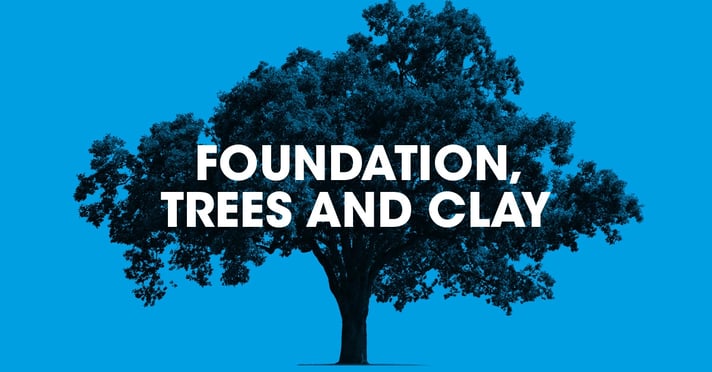Interactions between trees and clay
The ‘Volume Change Potential’ of a soil refers to the expected relative change in its volume due to variations in moisture content. As a soil's moisture level fluctuates due to drying or rainfall, it may shrink or swell. Soil containing cohesive soils, such as clay, are particularly susceptible to shrinkage or swelling.
As the roots of all trees take water from the soil to make good the water lost from the leaves (often referred to as their water demand), their presence means water and moisture is lost from the soil, which directly influences changes in the soils volume as a result of shrinkage. Similarly, if those trees are removed, the water that was naturally removed from the soil returns over time, causing a rehydration of the soil and changes in the soils volume as swelling or expansion.
The potential for either shrinkage or expansion of soil can be variable and unpredictable, and depends upon:
Soil type
Soils can be broadly classified into two types: cohesive soils (mainly clay) and non-cohesive soils (mainly gravels, sands, and silts). Cohesive soils, which contain clay particles, can shrink or swell due to changes in moisture content, potentially damaging foundations if not properly accounted for.
To determine a soil's potential for volume change, simple tests can be conducted to measure moisture content, plastic limit, and liquid limit. These tests can help determine the plasticity index, which indicates the soil's potential for volume change. Site investigations, including trial holes and soil sampling, are necessary to determine the soil type and its potential impact on foundations, especially in areas with adjacent trees.
Tree species, size and water demand
Tree species vary in their water demand, with some (like Oak, Poplar, and Eucalyptus) being high-demand and others being low-demand. The root system of trees also differs, with hardwoods having a broad, spreading system and conifers having a more localized influence. The amount of water a tree takes up is related to its leaf area, which is often indicated by its height, particularly at maturity. Trees with greater height tend to have greater water uptake, and even trees in groups or rows are considered individually based on their mature height, as they compete with each other for resources.
Proximity
The distance between a tree and a building affects the required foundation depth, with closer proximity requiring deeper foundations. To determine the required depth, measurements are taken from the centre of the tree trunk to the nearest part of the foundation. The foundation depth can be adjusted, with the deepest depth required closest to the tree, and can be stepped down as the distance from the tree increases.
The local climate conditions
Weather conditions play a major role in determining the extent of soil drying. Hot sunny weather will increase the rate of water uptake by the roots, whereas rainfall during the summer can restore the water that has been taken. As the hottest and driest conditions tend to be in South East England, it has the greatest risk. For other parts of the country the guidance allows for reducing the required foundation depth where the risk is less.
What are the Warranty providers concerns?
Where clays soils and trees are present on site, and the potential impact associated with either shrinkage or expansion of soil are allowed to extend beneath foundations, the foundations will subside or heave respectively.If the movements are in excess of those that can be tolerated by the building, damage is likely to occur.
Warranty stance
Where Developments are affected by the presence of clays soils and trees, a failure to identify the extent of any impact on buildings and not applying suitable controls to combat the effects the trees may have on soils is considered to compromise the ability of the building(s) in meeting with the Functional Requirements and Performance Standards stipulated by the Technical Manual, notably those relating to structural performance and durability.
What Developers should action after reading this document?
To help simplify the process for determining the required depth for a foundation to a building, Developers are advised to use our ‘Foundation Depth Calculator’ which can be found on our website.
To use it, you will need to have the following information available:
- The extent of any slope existing on the site.
- Post code for the site location.
- The volume change potential of the soil (plasticity index) if known.
- The type of tree which is near to the proposed building. From this, the water demand of the tree will be determined.
- Distance of relevant tree to nearest part of foundations.
To supplement the use of the ‘Foundation Depth Calculator’, more expansive information on the points briefly covered in this guidance document and more on what allowance for ‘heave precautions’ may be required for both the foundations and the ground floor constructions, sloping sites and where shrinkable soils are present below non shrinkable soils is available within the ‘Foundations’ section of our Technical Manual.

